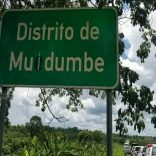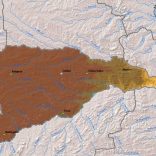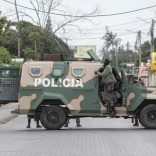Mozambique: One killed by terrorists in Magaia village - AIM report
Mozambique: Maputo water shortage solved by August 2020

Photo: Noticias
The Mozambican Minister of Public Works, Joao Machatine, on Thursday pledged that the problem of water shortages in the Greater Maputo area will be definitively solved by August 2020.
He gave this guarantee in Moamba district, about 60 kilometres north of Maputo, after visiting the work on completing the flood gates on the Corumana dam, on the Sabie river, the main tributary of the Incomati.
Up until now, greater Maputo (Maputo and Matola cities, and Boane and Marracuene districts) have drawn the bulk of their water from the Pequenos Libombos dam on the Umbeluzi river. Since 2015, drought in Maputo province has forced the level of water in the Pequenos Libombos reservoir down to dangerously low levels, leading to restrictions in water supply in Greater Maputo.
In its search for alternative sources of water for the capital, the government has turned to Corumana. It has built a 95 kilometre long mains pipeline from Corumana to the water distribution centre in the Matola neighbourhood of Machava, and a new water treatment station on the Sabie.
In addition, boreholes have been drilled in the outlying Maputo neighbourhoods, and small scale water systems that were out of order have been repaired.
The Umbeluzi will still supply the greater part of Maputo’s water supply (around 240,000 cubic metres a day) said Machatine. But this will be supplemented by 30,000 cubic metres a day from Corumana and a further 30,000 cubic metres from the boreholes.
The amount of water piped from the Corumana reservoir will double, to 60,000 cubic metres a day, once a larger treatment station on the Sabie is completed in August next year.
Machatine was confident that, in the near future, this will allow water to be supplied to Greater Maputo 24 hours a day. With all sources taken into consideration, Greater Maputo could be receiving over 350,000 cubic metres of water a day, the Minister said.
“With this capacity, we can state with full certainty that the Greater Maputo water supply problem will be definitively solved”, he declared. “I am saying that this entire region – Marracuene, Maputo city, Matola, Boane, and other surrounding neighbourhoods – will have its water shortage problem solved”.
The infrastructure required for this expansion cost about 4.4 billion meticais (about 71 million US dollars, at current exchange rates), financed partly from the Mozambican state budget, and partly from the government’s international partners.
Machatine added that critics would no longer be able to use Maputo’s water shortage to attack the government “because we will have the opportunity to see water flowing from all the taps 24 hours a day”.
The Corumana dam was built between 1983 and 1989, mainly for flood control, to provide water to irrigate 36,000 hectares of farmland in the Incomati Valley, and to produce 16.2 megawatts of electricity.
The original plan was for the Corumana reservoir to store 1.24 billion cubic metres of water. But, thanks mainly to the war of destabilisation waged by the apartheid regime through the Renamo rebels, the planned floodgates were never installed, and the storage capacity was reduced to the current 720 million cubic metres. Only now is work on the floodgates being completed.













Leave a Reply
Be the First to Comment!
You must be logged in to post a comment.
You must be logged in to post a comment.